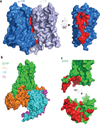A new era of GPCR structural and chemical biology
- PMID: 22810761
- PMCID: PMC4031315
- DOI: 10.1038/nchembio.1025
A new era of GPCR structural and chemical biology
Abstract
G protein-coupled receptors (GPCRs) are versatile molecular machines that regulate the majority of physiological responses to chemically diverse hormones and neurotransmitters. Recent breakthroughs in structural studies have advanced our understanding of GPCR signaling, particularly the selectivity of ligand recognition and receptor activation of G proteins.
Figures



References
MeSH terms
Substances
Grants and funding
LinkOut - more resources
Full Text Sources
Other Literature Sources

